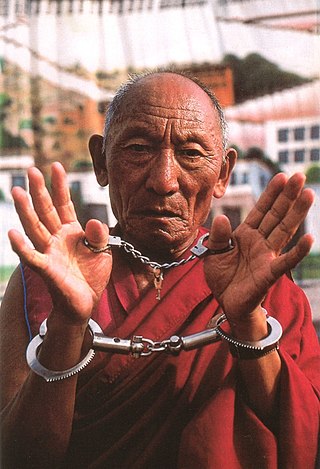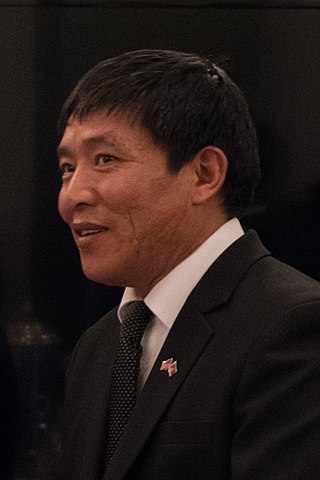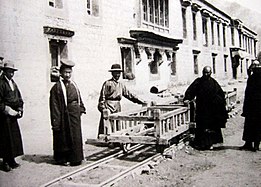Free Tibet (FT) is a non-profit, non-governmental organisation, founded in 1987 and based in London, England. According to their mission statement, Free Tibet advocates for "a free Tibet in which Tibetans are able to determine their own future and the human rights of all are respected."

Takna Jigme Sangpo was the longest-serving political prisoner of Tibetan ethnicity, having spent 37 years in a prison near Lhasa.

The history of Tibet from 1950 to the present includes the Chinese invasion of Tibet in 1950, and the Battle of Chamdo. Before then, Tibet had been a de facto independent nation. In 1951, Tibetan representatives in Beijing signed the Seventeen Point Agreement under duress, which affirmed China's sovereignty over Tibet while it simultaneously supported the establishment of an autonomous administration which would be led by Tibet's spiritual leader, and then-political leader, the 14th Dalai Lama. During the 1959 Tibetan uprising, when Tibetans attempted to prevent his possible assassination, the Dalai Lama escaped from Tibet and moved to northern India, where he established the Central Tibetan Administration, which rescinded the Seventeen Point Agreement. The majority of Tibet's land mass, including all of U-Tsang and areas of Kham and Amdo, was officially established as the Tibet Autonomous Region, within China, in 1965.

Ngawang Sangdrol is a former political prisoner, imprisoned at the age of 13 by the Government of the People's Republic of China, for peacefully demonstrating against the Chinese occupation of Tibet in 1992. She was at first held for eight months without trial, before being sentenced to a three-year prison term. Her sentence was extended repeatedly for continued protest in prison, which included recording a tape of freedom songs with 13 other nuns from Drapchi Prison that was smuggled out of Tibet.
Marie Louville, is a French journalist, an expert on Tibet, and a director of documentary films on Tibet.
Phuntsog Nyidron is a Tibetan Buddhist nun and a former high-profile prisoner in Tibet. In 1989, she and eight other nuns traveled from her hometown to the provincial capital of Lhasa when it was convulsed by Tibetan independence protests and riots, and handed out leaflets and shouted anti-Chinese slogans. She was tried and imprisoned for the charge of counterrevolutionary propaganda and incitement and imprisoned at the Drapchi Prison that same year. During her incarceration, she produced and smuggled out tapes of her and other prisoners' political songs, engaged in hunger strikes, and made publicized allegations of mistreatment. One of the better-known Tibetan prisoners outside Tibet, she was the subject of a release campaign by several United States Congress parliamentarians and governmental groups. Because of their efforts, and Chinese wishes to improve Sino-American relations, her sentence was reduced and commuted in 2004. She lives in Switzerland since 2006.

Palden Gyatso was a Tibetan Buddhist monk. Arrested for protesting during the Chinese invasion of Tibet, he spent 33 years in Chinese prisons and labor camps, where he was extensively tortured, and served the longest term of any Tibetan political prisoner. After his release in 1992 he fled to Dharamsala in North India, in exile. He was still a practicing monk and became a political activist, traveling the world publicizing the cause of Tibet up until his death in 2018. His autobiography Fire Under the Snow is also known as The Autobiography of a Tibetan Monk. He was the subject of the 2008 documentary film Fire Under the Snow.

The 2008 Tibetan unrest, also referred to as the 2008 Tibetan uprising in Tibetan media, was a series of protests and demonstrations over the Chinese government's treatment and persecution of Tibetans. Protests in Lhasa, the capital of Tibet, by monks and nuns on 10 March have been viewed as the start of the demonstrations. Numerous protests and demonstrations were held to commemorate the 49th anniversary of the 1959 Tibetan Uprising Day, when the 14th Dalai Lama escaped from Tibet. The protests and demonstrations spread spontaneously to a number of monasteries and throughout the Tibetan plateau, including into counties located outside the designated Tibet Autonomous Region. The arrest of monks at Labrang Monastery increased the tension of the situation. Clashes occurred between Tibetans and Chinese Han and Hui residents, resulting in Han and Hui stores and buildings being destroyed and numerous Chinese civilians being injured or killed.

Tibetan Uprising Day, observed on March 10, commemorates the 1959 Tibetan uprising which began on March 10, 1959, and the Women's Uprising Day of March 12, 1959, involving thousands of women, against the presence of the People's Republic of China in Tibet.
The serfdom in Tibet controversy is a prolonged public disagreement over the extent and nature of serfdom in Tibet prior to the annexation of Tibet into the People's Republic of China (PRC) in 1951. The debate is political in nature, with some arguing that the ultimate goal on the Chinese side is to legitimize Chinese control of the territory now known as the Tibet Autonomous Region or Xizang Autonomous Region, and others arguing that the ultimate goal on the Western side is to weaken or undermine the Chinese state. The argument is that Tibetan culture, government, and society were feudal in nature prior to the PRC takeover of Tibet and that this only changed due to PRC policy in the region. The pro-Tibetan independence movement argument is that this is a misrepresentation of history created as a political tool in order to justify the Sinicization of Tibet.
The 1987–1989 Tibetan unrest was a series of protests and demonstrations that called for Tibetan independence. These protests took place between September 1987 and March 1989 in the Tibet Autonomous Region, in the Tibetan regions of Sichuan, and Qinghai, as well as the Tibetan prefectures in Yunnan and Gansu. Protests began shortly after the Dalai Lama, the religious and temporal leader of Tibet exiled in India since the 1959 Tibetan unrest, proposed a Five Point Peace Plan regarding the “status of Tibet” on September 21, 1987, which was subsequently rejected by the Chinese government. The Plan advocated for greater respect and autonomy of the Tibetan people, and claimed that “Tibet was a fully independent state when the People’s Liberation Army invaded the country in 1949-50.” China rejected the idea of Tibetans as an invaded people, stating that “Tibet is an inalienable part of Chinese territory” and has been for hundreds of years. The Tibetan sovereignty debate is longstanding, and the Tibetan assertion that they are a separate and unique people invaded by China has become a central argument for their independence.
Passang Lhamo is a Tibetan nun, former political prisoner, activist.
Wangdu is a former Tibetan monk who became an HIV/AIDS activist at the age of 41. He was sentenced to life imprisonment in 2008 for "endangering state security", and in 2012 he was in hospital.

Human rights in Tibet are a contentious issue. Reported abuses of human rights in Tibet include restricted freedom of religion, belief, and association; arbitrary arrest; maltreatment in custody, including torture; and forced abortion and sterilization. The status of religion, mainly as it relates to figures who are both religious and political, such as the exile of the 14th Dalai Lama, is a regular object of criticism. Additionally, freedom of the press in China is absent, with Tibet's media tightly controlled by the Chinese leadership, making it difficult to accurately determine the scope of human rights abuses.
The Tibetan Centre for Human Rights and Democracy (TCHRD) is a Tibetan non-governmental nonprofit human rights organization.

Protests and uprisings in Tibet against the government of the People's Republic of China have occurred since 1950, and include the 1959 uprising, the 2008 uprising, and the subsequent self-immolation protests.

Dhondup Wangchen is a Tibetan filmmaker imprisoned by the Chinese government in 2008 on charges related to his documentary Leaving Fear Behind. Made with senior Tibetan monk Jigme Gyatso, the documentary consists of interviews with ordinary Tibetan people discussing the 14th Dalai Lama, the Chinese government, the 2008 Beijing Olympics, and Han Chinese migrants to the region. After smuggling the tapes of the interviews out of Tibet, however, Dhondup Wangchen and Jigme Gyatso were detained during the 2008 Tibetan unrest.

Drapchi is a 2013 Tibetan-language Film directed by Arvind Iyer and stars acclaimed Tibetan singer Namgyal Lhamo in the lead role as Yiga Gyalnang. The film is a musical drama set against the backdrop of Tibet and Nepal and based on a true story. Drapchi has screened at the Manneim-Heidelberg, Cairo International, Warsaw International, Kerala International and Rome Independent Film Festival.

Jigme Gyatso is a Tibetan activist of the Tibetan Independence Organisation who, in 1996, was sentenced to 15 years in prison on charges of "leading a counter-revolutionary organisation" and "inciting splittism". Two more years were added to his sentence in 2004 when he protested in jail. Several international human rights groups have protested or campaigned on his behalf, and Amnesty International has designated him a prisoner of conscience.

Lobsang Tashi, also known as Khenchen Lobsang Tashi (1897–1966) was a Tibetan politician who was a senior monastic official and the monastic prime minister (sileun) of the Tibetan government during the early Chinese occupation of Tibet. After the departure of the 14th Dalai Lama in 1959, he was incarcerated in Drapchi Prison where he died in 1966.
















